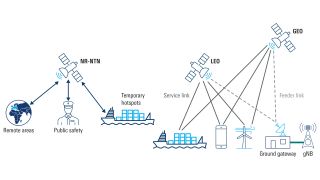Connecting the world with 5G NTN
What is NTN?
Non-terrestrial networks (NTN) are wireless communication systems that operate above the Earth’s surface, involving satellites at low Earth orbit (LEO), medium Earth orbit (MEO) and geostationary orbit (GEO), high-altitude platforms (HAPS) and drones. Such components are essential to realizing seamless coverage, bringing coverage even to remote areas that do not have access to traditional terrestrial networks.
Today, devices are separated into those connected to the 3GPP terrestrial network and those connected to satellite. In other words, users that require satellite connection need another device alongside their existing smartphone. With NTN, all mobile devices will be connected to both terrestrial and satellite networks as part of the 3GPP ecosystem. And as the technology continuously evolves, the satellites will become the base stations.












